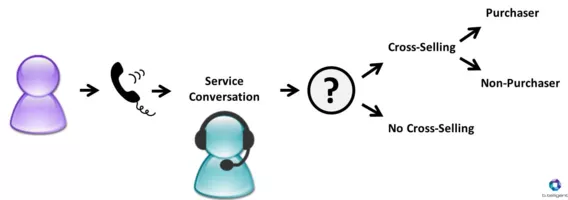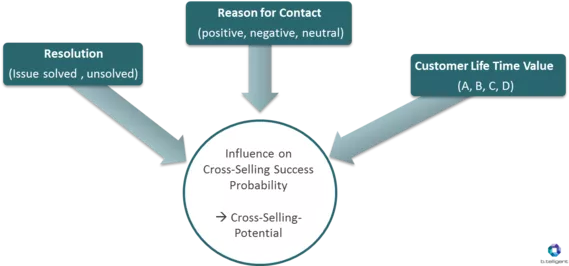Starting Situation
Cross- and up-selling in the call center are long-established methods to make additional profits. However, the increase in turnover due to cross-selling should not be detrimental to the service level.
Blanket Selling or Optimized Selling?
Should cross-selling be operated always and with each customer or only if the probability of success is high for the customers and the current utilization is low?
The questions when and to whom a cross-selling attempt should be made in order to increase the profits and maintain the service level have been answered within the scope of the research project PROSET by simulating various scenarios.
Approach
On the basis of the data of a telecommunications service provider various cross- and up-selling strategies were analyzed with regard to
- personnel requirements
- sales figures
- service level
- realized profit.
In order to be able to define the possible scenarios, the possible day and week times were first analyzed with regard to the respective utilization and subsequently divided into periods with high, medium and low utilization.
The probability of cross-selling success was calculated on the basis of the customer categories customer life time value, reason for calling and resolution status. These factors were explored within the scope of the project and presented in this blog:
Based on these factors, all customers were divided into the following categories based on their cross-selling success probability: total number of customers, 25% percentile, 50% percentile and 75% percentile.
An sample scenario is presented in the following table. Here, 1 means that cross-selling attempts have been made, 0 means that no cross selling attempts have been made. In this case, only customers with a success probability above the 25% percentile are addressed in periods of low utilization. By contrast, in periods of medium utilization only customers with a success probability above the 50% percentile are contacted. In periods of high utilization no cross- and up-selling is operated. Currently, the agents have the target to make a cross-selling attempt during each call. If this actual state were depicted in the table, there would be a 1 in each field for the respective cross-selling attempt.
By means of a simulation, the sales figures and the personnel requirements were identified for the various scenarios. Based on this, the profit was calculated as turnover from sales less personnel costs and commission expenses.
Results - higher profits despite Fewer cross-selling attempts
The analysis of the results showed that a higher profit is possible despite a lower number of cross- selling attempts. Due to the optimization, more than 90% of the sales can be achieved by 75% of the cross-selling attempts. Only 86% of the personnel resources are required for this. In other words, that means a higher profit for the business.
- Thus, the profit can be increased by reducing the cross-selling attempts
- In this context, it is important that cross-selling is attempted on the right customers, i.e. the customers with the highest probability of success.
The project is supported by the Federal Ministry of Education and Research, the Project Management Agency of the German Aerospace Center (DLR) and the Strategic Partnership "Productivity of Services".
The complete study is expected to be published in July 2014. You will find more detailed information here at CI Insights.










